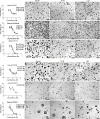Psymberin, a marine-derived natural product, induces cancer cell growth arrest and protein translation inhibition
- PMID: 36743670
- PMCID: PMC9894252
- DOI: 10.3389/fmed.2022.999004
Psymberin, a marine-derived natural product, induces cancer cell growth arrest and protein translation inhibition
Erratum in
-
Corrigendum: Psymberin, a marine-derived natural product, induces cancer cell growth arrest and protein translation inhibition.Front Med (Lausanne). 2023 May 31;10:1193745. doi: 10.3389/fmed.2023.1193745. eCollection 2023. Front Med (Lausanne). 2023. PMID: 37324143 Free PMC article.
Abstract
Colorectal cancer (CRC) is the third most prevalent form of cancer in the United States and results in over 50,000 deaths per year. Treatments for metastatic CRC are limited, and therefore there is an unmet clinical need for more effective therapies. In our prior work, we coupled high-throughput chemical screens with patient-derived models of cancer to identify new potential therapeutic targets for CRC. However, this pipeline is limited by (1) the use of cell lines that do not appropriately recapitulate the tumor microenvironment, and (2) the use of patient-derived xenografts (PDXs), which are time-consuming and costly for validation of drug efficacy. To overcome these limitations, we have turned to patient-derived organoids. Organoids are increasingly being accepted as a "standard" preclinical model that recapitulates tumor microenvironment cross-talk in a rapid, cost-effective platform. In the present work, we employed a library of natural products, intermediates, and drug-like compounds for which full synthesis has been demonstrated. Using this compound library, we performed a high-throughput screen on multiple low-passage cancer cell lines to identify potential treatments. The top candidate, psymberin, was further validated, with a focus on CRC cell lines and organoids. Mechanistic and genomics analyses pinpointed protein translation inhibition as a mechanism of action of psymberin. These findings suggest the potential of psymberin as a novel therapy for the treatment of CRC.
Keywords: high-throughput screening; patient-derived models of cancer; patient-derived organoids; precision medicine; protein translation; psymberin.
Copyright © 2022 Dayanidhi, Somarelli, Mantyh, Rupprecht, Roghani, Vincoff, Shin, Zhao, Kim, McCall, Hong and Hsu.
Conflict of interest statement
DH was cofounder of Xilis. The remaining authors declare that the research was conducted in the absence of any commercial or financial relationships that could be construed as a potential conflict of interest.
Figures





Similar articles
-
Corrigendum: Psymberin, a marine-derived natural product, induces cancer cell growth arrest and protein translation inhibition.Front Med (Lausanne). 2023 May 31;10:1193745. doi: 10.3389/fmed.2023.1193745. eCollection 2023. Front Med (Lausanne). 2023. PMID: 37324143 Free PMC article.
-
A Precision Medicine Drug Discovery Pipeline Identifies Combined CDK2 and 9 Inhibition as a Novel Therapeutic Strategy in Colorectal Cancer.Mol Cancer Ther. 2020 Dec;19(12):2516-2527. doi: 10.1158/1535-7163.MCT-20-0454. Epub 2020 Nov 6. Mol Cancer Ther. 2020. PMID: 33158998 Free PMC article.
-
Development of a precision medicine pipeline to identify personalized treatments for colorectal cancer.BMC Cancer. 2020 Jun 24;20(1):592. doi: 10.1186/s12885-020-07090-y. BMC Cancer. 2020. PMID: 32580713 Free PMC article.
-
Preclinical models as patients' avatars for precision medicine in colorectal cancer: past and future challenges.J Exp Clin Cancer Res. 2021 Jun 5;40(1):185. doi: 10.1186/s13046-021-01981-z. J Exp Clin Cancer Res. 2021. PMID: 34090508 Free PMC article. Review.
-
Patient derived organoids in prostate cancer: improving therapeutic efficacy in precision medicine.Mol Cancer. 2021 Sep 29;20(1):125. doi: 10.1186/s12943-021-01426-3. Mol Cancer. 2021. PMID: 34587953 Free PMC article. Review.
Cited by
-
Tumor organoids in cancer medicine: from model systems to natural compound screening.Pharm Biol. 2025 Dec;63(1):89-109. doi: 10.1080/13880209.2025.2458149. Epub 2025 Feb 1. Pharm Biol. 2025. PMID: 39893515 Free PMC article. Review.
References
-
- Rodriguez-Bigas MA, Lin EH, Crane CH. Stage IV Colorectal Cancer. In: Kufe DW, Pollock RE, Weichselbaum RR. editors. Cancer Medicine. Hamilton, ON: BC Decker; (2003).
-
- Grothey A, Van Cutsem E, Sobrero A, Siena S, Falcone A, Ychou M, et al. Regorafenib monotherapy for previously treated metastatic colorectal cancer (CORRECT): an international, multicentre, randomised, placebo-controlled, phase 3 trial. Lancet. (2012) 381:303–12. 10.1016/S0140-6736(12)61900-X - DOI - PubMed
Grants and funding
LinkOut - more resources
Full Text Sources

